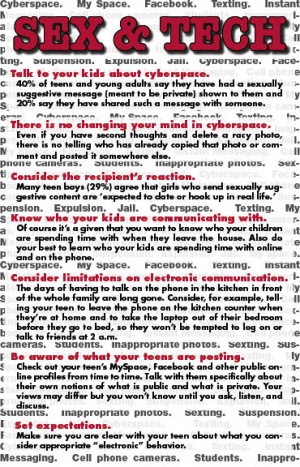One of our staff members is contributing considerably to a News Archiving service at Mu. Any well educated (Masters, PhD or above) users who wish to make comments on news sites, please contact Jim Burton directly rather than using this list, and we can work on maximising view count.
Sexting

"Sexting" is a single letter sharing portmanteau (Sex+ texting) coined to describe the use of text messaging for sexual purposes - sending nude or suggestive pictures, sexual messages, and so on.
It is essentially a technologically updated version of the "I'll show you mine..." game. The trend has worried many; while some continue to be horrified by young people's sexuality, most take issue with the implications of this electronic form of teenage sexuality. The most publicized sexting cases have involved pictures (originally intended for one person) that are circulated among school populations, prompting many to speculate that such pictures (often classified as child pornography) eventually make their way to the internet.
The internet, of course, is an old friend of those who object to child sexuality. The standard arguments regarding internet content have been applied to sexting: nothing will stay private, everything is permanent, nothing is truly anonymous, and everyone could be a predator.
Sexting was reported as early as 2005 in the UK's Sunday Telegraph Magazine,[1] and has since been described as taking place worldwide.[2] It has been reported in the U.K.,[1] Australia,[3] New Zealand,[2] the U.S.,[4] and Canada.
Frequency
The National Campaign to Prevent Teen and Unplanned Pregnancy[5] released a study (pdf)[6] in December 2008 that concluded about one in five teens have sent or posted a nude or semi-nude picture of themselves on the internet. The study was conducted online by an independent firm; it queried 653 teens aged 13-19.
Some of the more interesting findings of the study are:
- 20% of teens (13-19) say they have sent/posted nude or semi-nude pictures
- 39% of teens say they have sent/posted sexually suggestive messages
- 75% of teens say sending sexually suggestive content "can have serious negative consequences" (this is slightly misleading; see the study for clarification).
Pew Internet[7] found the following:
- 4% of cell-owning teens ages 12-17 say they have sent sexually suggestive nude or nearly nude images of themselves to someone else via text messaging
- 15% of cell-owning teens ages 12-17 say they have received sexually suggestive nude or nearly nude images of someone they know via text messaging on their cell phone.
- Older teens are much more likely to send and receive these images; 8% of 17-year-olds with cell phones have sent a sexually provocative image by text and 30% have received a nude or nearly nude image on their phone.
- The teens who pay their own phone bills are more likely to send “sexts”: 17% of teens who pay for all of the costs associated with their cell phones send sexually suggestive images via text; just 3% of teens who do not pay for, or only pay for a portion of the cost of the cell phone send these images.
Legal Action
Legal consequences of sexting remain murky. Phillip Alpert, 18, was convicted for sending child pornography and forced to register as a sex offender after he sent nude photographs of his 16-year-old girlfriend to her friends and family. He has since been kicked out of college, lost many friends, and has had trouble finding a job. [1]
A Pennsylvania case, however, had a much different outcome. The case involved two photos of three teenage girls (one with bras on, one with exposed breasts). A district attorney attempted to force the girls to participate in a "re-education" program, threatening child pornography charges. With the help of the ACLU, a federal judge ruled that the district attorney could not charge the girls with the production of child pornography.
In May 2009, the Missouri Senate amended an omnibus crime bill, potentially making sexting a class B misdemeanor, though the minor would not have to register as a sex offender. [2]
Jesse Logan
Jessica Logan, an 18-year-old American girl, committed suicide in July 2008, after having images of her nude body circulated at her school. The media - and Jesse's mother, Cynthia Logan - have singled out the photos as the cause of Jesse's suicide, and now uphold Jesse as what can happen from sexting.[3]
In May 2009, Senators Bob Menendez and Debbie Wasserman-Schultz introduced The Safety Internet Act. The act proposes to provide funding for non-profit organizations concerned with internet safety, in order to allow such organizations to work with schools and integrate internet safety into classroom curricula.[4]. Cynthia Logan attended the press conference, and stressed that her daughter's school did not take action.
References
- ↑ 1.0 1.1 Yvonne Roberts, "The One and Only" (2005-07-31), Sunday Telegraph Magazine, p.22 "Following a string of extramarital affairs and several lurid "sexting" episodes, Warne has found himself home alone, with Simone Warne taking their three children and flying the conjugal coop."
- ↑ 2.0 2.1 Phil Hamilton, "Teen 'sexting' alarms cyber-safety experts", The Press, 2008-07-12
- ↑ Inga Gilchrist, "Student knickers in a not; 'Sexting' shocks parents, police", mX (newspaper), 2008-06-23
- ↑ Gigi Stone, "Sexting", World News with Charles Gibson, 2008-12-03
- ↑ http://www.thenationalcampaign.org/
- ↑ http://www.thenationalcampaign.org/sextech/PDF/SexTech_PressReleaseFIN.pdf
- ↑ http://www.pewinternet.org/Reports/2009/Teens-and-Sexting.aspx?r=1